Pablita Velarde (1918-2006) was born in the Santa Clara Pueblo in Espanola, New Mexico. Her Indian name Tse Tsan means Golden Dawn in the Tewa language. Velarde is one of America’s foremost Native American painters. She and her sister attended St Catherine’s Indian School in Sante Fe. At age fourteen Pablita was one of the first women to attend the Studio Art School in in Santa Fe, founded by Dorothy Dunn in1932. She taught what she called “flat-style painting,” memory paintings intended to preserve the old ways of the Pueblo before they disappeared.
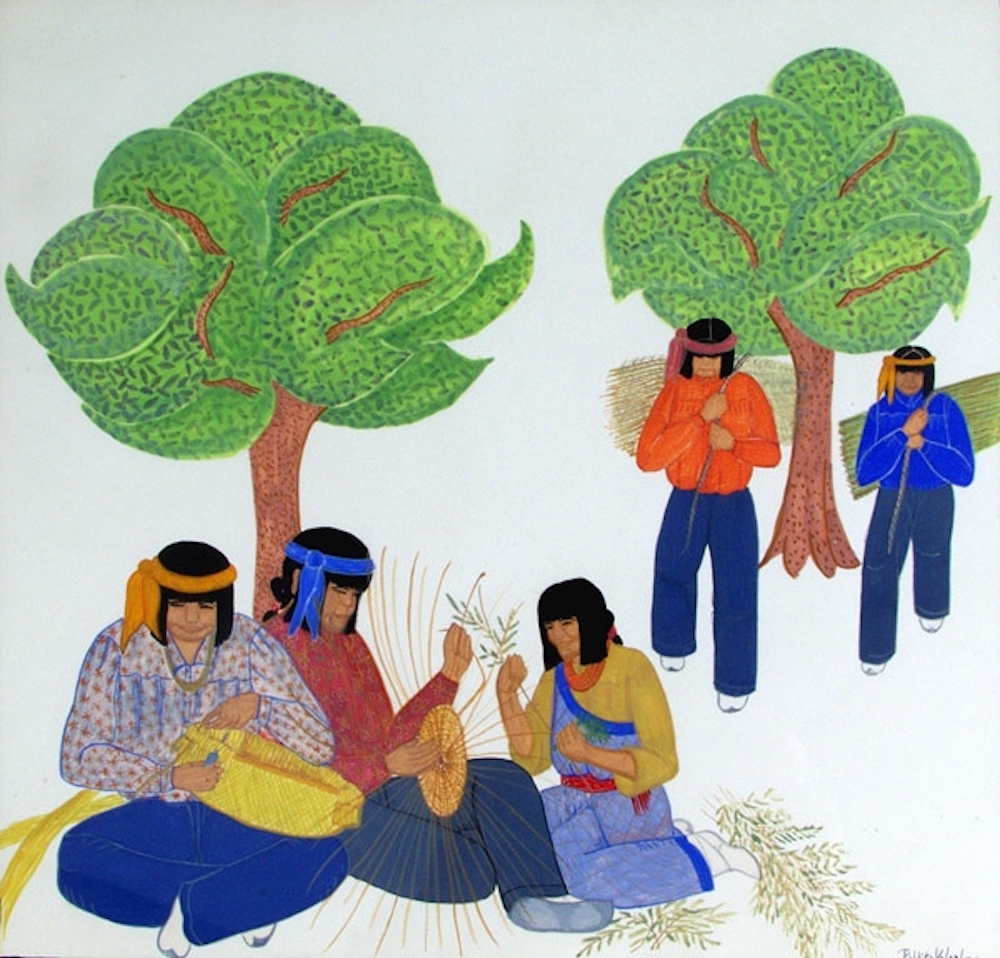
“Basket Making” (1940s)
Velarde received a commission in 1939 to paint scenes of traditional Indian life prior to1900. The work was a WPA project, part of the National Park Service, for the visitor center at the Bandelier National Monument in Los Alamos, New Mexico. She began the project in 1937, and she completed over 700 paintings by 1943. “Basket Making” (1940s) (12’’x11’’), in the flat-style, is a depiction of a man wearing a red shirt, sitting under a tree, and weaving a basket of yucca leaves. The man beside him is weaving a twill basket. The woman next the them is stripping the leaves from the yucca stem. Two men in the distance carry bundles of yucca leaves and flat stems that would be used to weave twill baskets. Velarde described her time at Bandelier: “I figure, I’ve learned more about my own people…than I would have…and I appreciate what the old ones have tried to pass on…I want the earth to remember me through my work.”
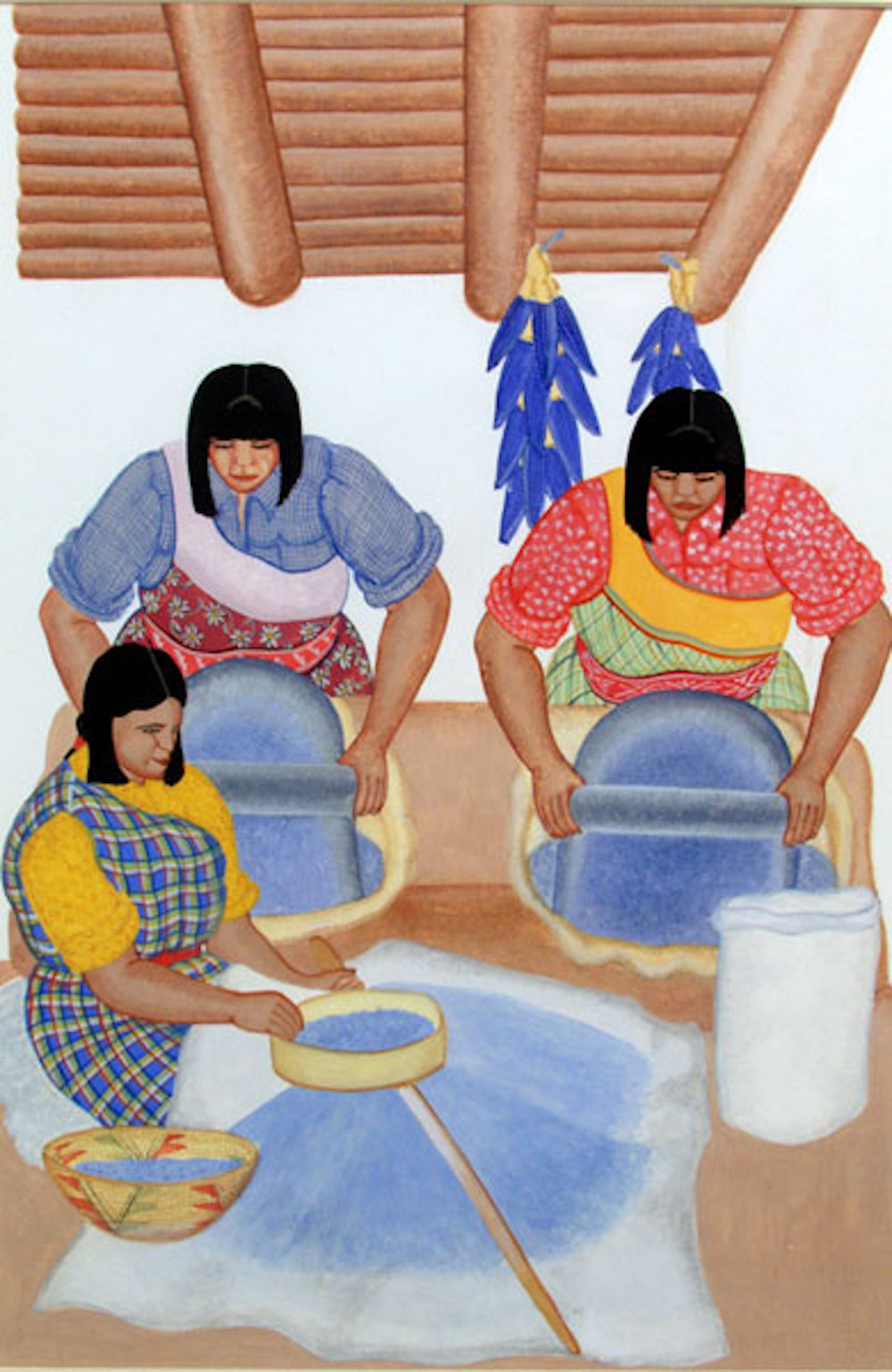
“Three Woman Grinding Corn” (1940s)
In “Three Woman Grinding Corn” (1940s) (13’’x8’’) Velarde depicts the process of grinding blue corn into flour. Cobs of blue corn hang at the rear of the pavilion, and two women are grinding corn in the traditional way, each using a manos, the long round stone rolled across a metates, the large stone on the ground. A third woman sifts the ground corn to remove any hard kernels. Pueblo Indians planted red, yellow, white, blue, black, and multicolored corn. Each had a particular use. Blue corn is high in protein and contains potassium and calcium, as well as other nutrients. It is also easier to digest and has antioxidant and anti-inflammatory properties.

”Santa Clara Women Selling Pottery” (1940s)
Maria Martinez (1887-1980), from San Ildefonso Pueblo, and her family of potters began experimenting with new techniques and created the world- famous black-ware pottery. “Santa Clara Women Selling Pottery” (1940s) is a display of black-ware pottery shapes and sizes, decorated with heavily incised traditional symbols. Behind the pots are eight colorfully dressed women of the Pueblo. One carries a papoose. Velarde has included a pueblo building behind them. Straight, symmetrical lines on a pot represent rain in the desert and feathers represent daily prayers. Among the other patterns are bear claws and Avanyu, the god who formed the Rio Grande River, and who is depicted as a water serpent.
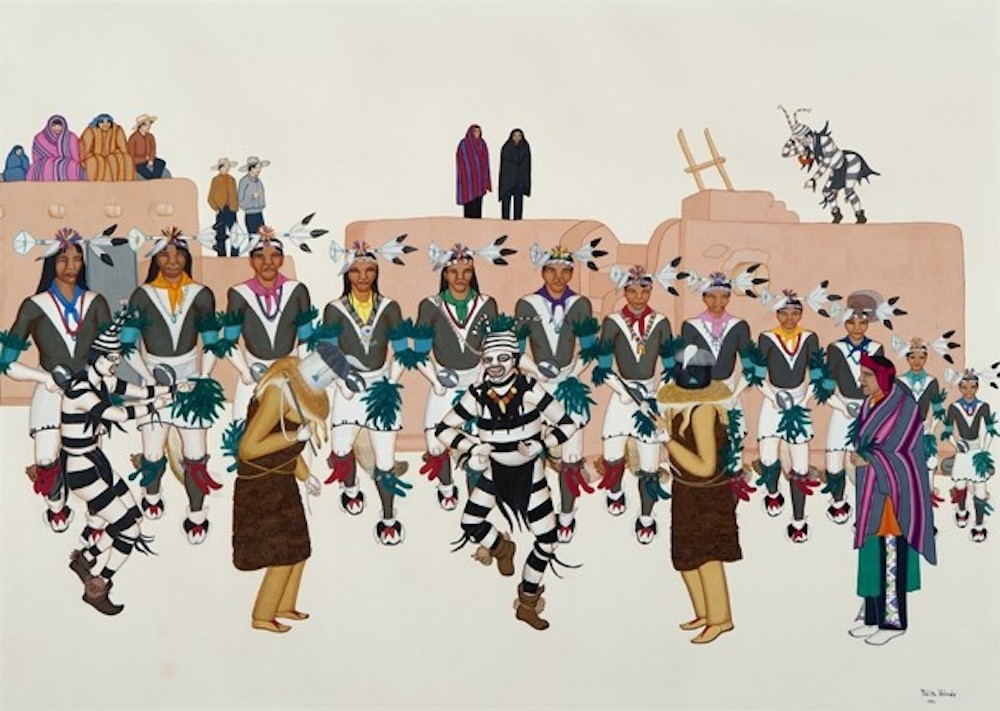
“Turtle Dance” (1953)
Velarde painted the traditions of the past in great detail. “Turtle Dance” (1953) is a depiction of a religious ceremony performed on January 1, the beginning of the new year. The turtle is believed to be the first animal to move at the arrival of the new year. Dancers wear evergreen branches, turtle shells, bells, and feathers. The sound of their moccasins scraping gently in the sand creates the sound of rain. The dancers welcome back the sun. The dance is performed by about 100 men, lined up according to their height from tallest to shortest, representing respect for the elders, who are the tallest. A new song is created each year to accompany the dance.
Two medicine men are in the front row. Between them, and to the left side of the painting, and on the roof of the pueblo are Koshare, dressed in black and white striped costume. They are clowns who participate in Pueblo ceremonies. They continue to participate to this day. On January 1, 2025, the Turtle Dance will be performed for the public at the Taos Pueblo.
In 1954 Velarde was awarded, along with eleven other Native Americans, the French Order of the Palmes for excellence in art. It was the first time foreigners were given this honor since it was founded by Napoleon in 1808.
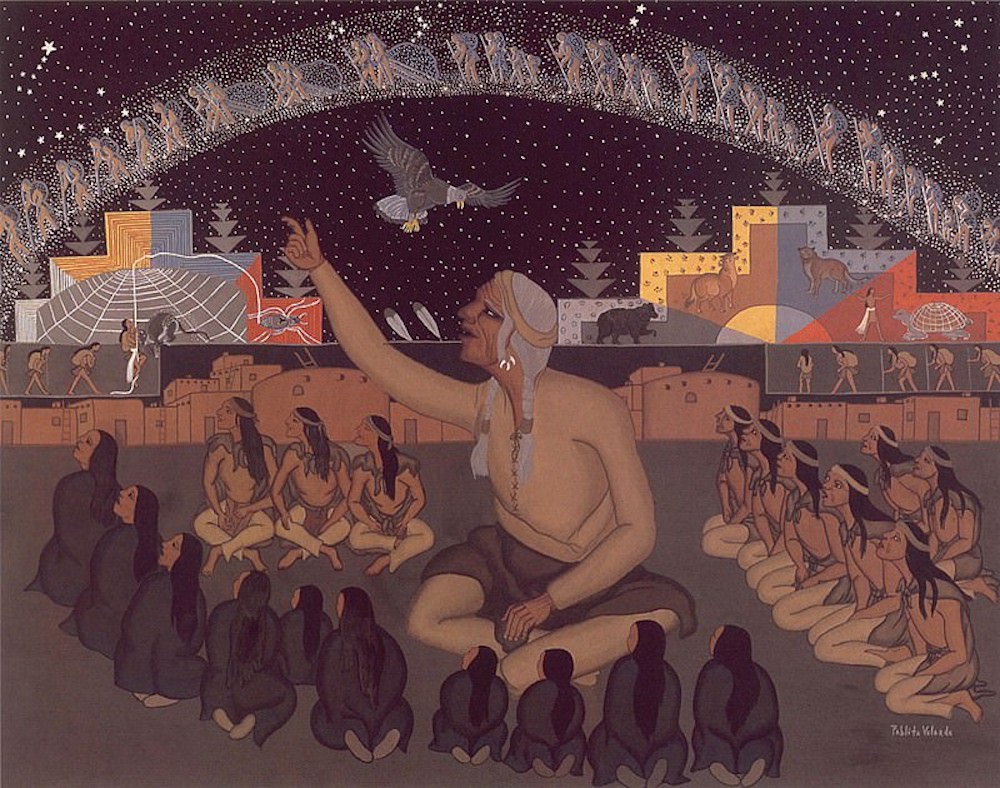
“Old Father Storyteller” (1960)
Velarde wrote and illustrated the children’s book Old Father Storyteller in 1960. It was one of her most popular images and the subject of “Old Father Storyteller” (1960) (18’’x14’’). The painting was made into a print. Velarde’s father was a respected storyteller at the Santa Clara Pueblo: “I was one of the fortunate children of my generation who were probably the last to hear stories firsthand from Great-grandfather or Grandfather. I treasure that memory, and I have tried to preserve it in this book so that my children as well as other people may have a glimpse of what used to be.”
In “Old Father Storyteller” the over-sized storyteller sits cross-legged at the center of the composition. He points to the arch of stars as he tells migration stories to the women, children, and men who listen intently. Velarde has included an imaginary structure composed of Indian patterns. It contains animals that are important to the people and part of the stories. A large spider web and spider appear on the left side of the work, with warriors trying to climb onto it. An eagle soars across the sky at the center, and a bear, two other animals, and a turtle occupy the right side. On both sides, warriors carrying sacks may be bringing offerings to the animals. The book was selected as one of the best Western books of 1960. It is still a best seller.
During Velarde’s long career, she received many honors. She was declared a Santa Fe Living Treasure in 1988. In 1990 Velarde received the Lifetime Achievement Award from the Women’s Caucus for Art. Founded in 1972, the organization supported women artists, art historians, students, educators, and museum professionals. Its affiliation with the United Nations in 1975 extended its influence beyond the United States. The Pablita Velarde Museum of Indian Women in the Arts was opened in Sante Fe in1912. She received a Doctorate in Arts from the University of New Mexico in Albuquerque in 2005, the year before her death.
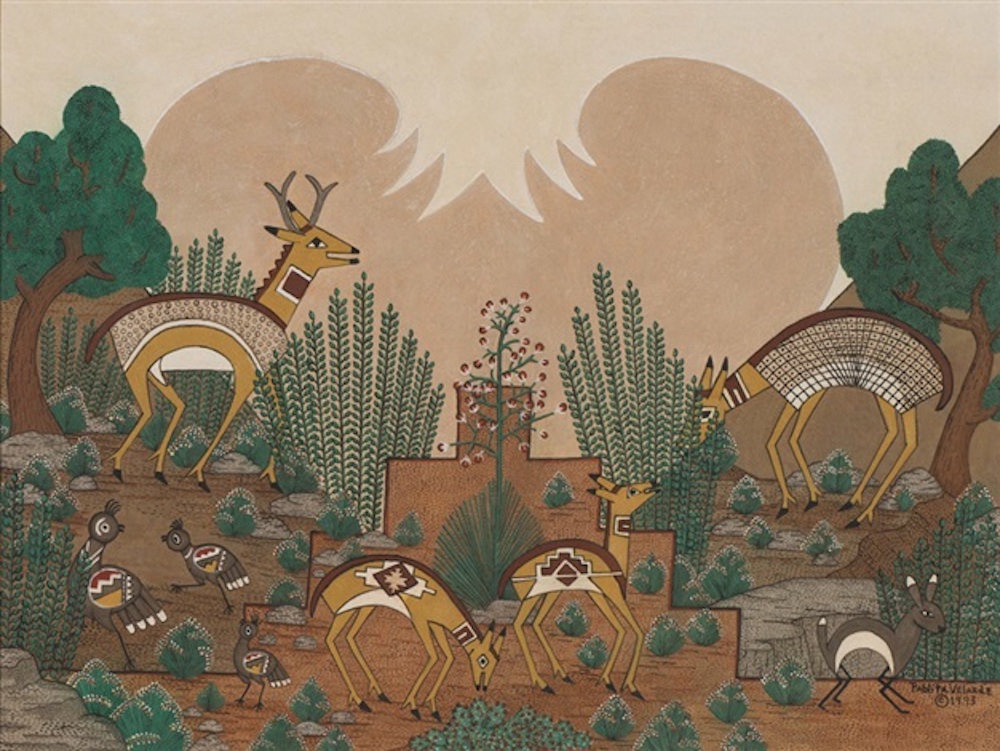
“Mimbres – Antelopes, Quails, and Rabbit” (1993)
Velarde’s painting skills developed during her career. She used several paint mediums, and she also made paint from natural materials which she used in what she called her earth paintings. “Mimbres – Antelopes, Quails, and Rabbit” (1993) (18’’x24’’) (print from an earth painting) is a depiction of one of her several Pueblo Indian subjects. The people and their customs included images of animals important to them. Mimbres indicates that the animals are kin, part of a group of persons with common ancestry. Velarde’s animal paintings are often childlike, but also are abstract. Antelope are a significant food source, and their hides are used for necessary items. Quail are considered sacred, and their feathers are used in ceremonies. They are messengers between the earth and sky, connecting the physical and spiritual worlds. They are also an important food source. Rabbits were a significant food source and respected. Each of the animals is painted with Pueblo patterns.

“First Twins” (1979)
In a 1979 interview, Velarde commented on women and painting: “Painting was not considered women’s work in my time. A woman was supposed to be just a woman, like a housewife and a mother and chief cook. Those things I wasn’t interested in.”
Beverly Hall Smith was a professor of art history for 40 years. Since retiring to Chestertown with her husband Kurt in 2014, she has taught art history classes at WC-ALL and the Institute of Adult Learning, Centreville. An artist, she sometimes exhibits work at River Arts. She also paints sets for the Garfield Theater in Chestertown.



Jenifer Emley says
Thank you, Beverly, for always enlightening us.
You are a treasure.